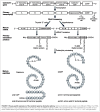Role of calcitonin gene-related peptide in cerebral vasospasm, and as a therapeutic approach to subarachnoid hemorrhage
- PMID: 23162536
- PMCID: PMC3498620
- DOI: 10.3389/fendo.2012.00135
Role of calcitonin gene-related peptide in cerebral vasospasm, and as a therapeutic approach to subarachnoid hemorrhage
Abstract
Calcitonin gene-related peptide (CGRP) is one of the most potent microvascular vasodilators identified to date. Vascular relaxation and vasodilation is mediated via activation of the CGRP receptor. This atypical receptor is made up of a G protein-coupled receptor called calcitonin receptor-like receptor (CLR), a single transmembrane protein called receptor activity-modifying protein (RAMP), and an additional protein that is required for Ga(s) coupling, known as receptor component protein (RCP). Several mechanisms involved in CGRP-mediated relaxation have been identified. These include nitric oxide (NO)-dependent endothelium-dependent mechanisms or cAMP-mediated endothelium-independent pathways; the latter being more common. Subarachnoid hemorrhage (SAH) is associated with cerebral vasoconstriction that occurs several days after the hemorrhage and is often fatal. The vasospasm occurs in 30-40% of patients and is the major cause of death from this condition. The vasoconstriction is associated with a decrease in CGRP levels in nerves and an increase in CGRP levels in draining blood, suggesting that CGRP is released from nerves to oppose the vasoconstriction. This evidence has led to the concept that exogenous CGRP may be beneficial in a condition that has proven hard to treat. The present article reviews: (a) the pathophysiology of delayed ischemic neurologic deficit after SAH (b) the basics of the CGRP receptor structure, signal transduction, and vasodilatation mechanisms and (c) the studies that have been conducted so far using CGRP in both animals and humans with SAH.
Keywords: CGRP; G proteins; GPCR; cerebral vasospasm; subarachnoid hemorrhage.
Figures



Similar articles
-
Effects of subarachnoid hemorrhage on vascular responses to calcitonin gene-related peptide and its related second messengers.J Neurosurg. 1995 Sep;83(3):516-21. doi: 10.3171/jns.1995.83.3.0516. J Neurosurg. 1995. PMID: 7666231
-
Characteristics of relaxation induced by calcitonin gene-related peptide in contracted rabbit basilar artery.J Neurosurg. 1995 Jan;82(1):91-6. doi: 10.3171/jns.1995.82.1.0091. J Neurosurg. 1995. PMID: 7815140
-
Direct interactions between calcitonin-like receptor (CLR) and CGRP-receptor component protein (RCP) regulate CGRP receptor signaling.Endocrinology. 2012 Apr;153(4):1850-60. doi: 10.1210/en.2011-1459. Epub 2012 Feb 7. Endocrinology. 2012. PMID: 22315449 Free PMC article.
-
Subarachnoid haemorrhage: what happens to the cerebral arteries?Clin Exp Pharmacol Physiol. 1998 Nov;25(11):867-76. doi: 10.1111/j.1440-1681.1998.tb02337.x. Clin Exp Pharmacol Physiol. 1998. PMID: 9807657 Review.
-
Heteroreceptors Modulating CGRP Release at Neurovascular Junction: Potential Therapeutic Implications on Some Vascular-Related Diseases.Biomed Res Int. 2016;2016:2056786. doi: 10.1155/2016/2056786. Epub 2016 Dec 27. Biomed Res Int. 2016. PMID: 28116293 Free PMC article. Review.
Cited by
-
The effect of anesthetic agents on cerebral vasospasms after subarachnoid hemorrhage: A retrospective study.Medicine (Baltimore). 2018 Aug;97(31):e11666. doi: 10.1097/MD.0000000000011666. Medicine (Baltimore). 2018. PMID: 30075557 Free PMC article.
-
The Vasodilatory Response to CGRP of the Anterior and Posterior Cerebral Circulation in Migraine.Front Neurol. 2022 May 19;13:854134. doi: 10.3389/fneur.2022.854134. eCollection 2022. Front Neurol. 2022. PMID: 35665038 Free PMC article.
-
Advances in the understanding of delayed cerebral ischaemia after aneurysmal subarachnoid haemorrhage.F1000Res. 2015 Nov 2;4:F1000 Faculty Rev-1200. doi: 10.12688/f1000research.6635.1. eCollection 2015. F1000Res. 2015. PMID: 26937276 Free PMC article. Review.
-
CRP deposition in human abdominal aortic aneurysm is associated with transcriptome alterations toward aneurysmal pathogenesis: insights from in situ spatial whole transcriptomic analysis.Front Immunol. 2024 Dec 16;15:1475051. doi: 10.3389/fimmu.2024.1475051. eCollection 2024. Front Immunol. 2024. PMID: 39737187 Free PMC article.
-
Neuropeptides in asthma, chronic obstructive pulmonary disease and cystic fibrosis.Respir Res. 2018 Aug 6;19(1):149. doi: 10.1186/s12931-018-0846-4. Respir Res. 2018. PMID: 30081920 Free PMC article. Review.
References
-
- Ahmad I., Imaizumi S., Shimizu H., Kaminuma T., Ochiai N., Tajima M., et al. (1996). Development of calcitonin gene-related peptide slow-release tablet implanted in CSF space for prevention of cerebral vasospasm after experimental subarachnoid haemorrhage. Acta Neurochir. (Wien) 138 1230–1240 - PubMed
-
- Aiyar N., Disa J., Stadel J. M., Lysko P. G. (1999). Calcitonin gene-related peptide receptor independently stimulates 3′,5′-cyclic adenosine monophosphate and Ca2+ signaling pathways. Mol. Cell. Biochem. 197 179–185 - PubMed
-
- Al-Tamimi Y. Z., Orsi N. M., Quinn A. C., Homer-Vanniasinkam S., Ross S. A. (2010). A review of delayed ischemic neurologic deficit following aneurysmal subarachnoid hemorrhage: historical overview, current treatment, and pathophysiology. World Neurosurg. 73 654–667 - PubMed
-
- Alevizaki M., Shiraishi A., Rassool F. V., Ferrier G. J., MacIntyre I., Legon S. (1986). The calcitonin-like sequence of the beta CGRP gene. FEBS Lett. 206 47–52 - PubMed
-
- Amara S. G., Jonas V., Rosenfeld M. G., Ong E. S., Evans R. M. (1982). Alternative RNA processing in calcitonin gene expression generates mRNAs encoding different polypeptide products. Nature 298 240–244 - PubMed
LinkOut - more resources
Full Text Sources
Research Materials

